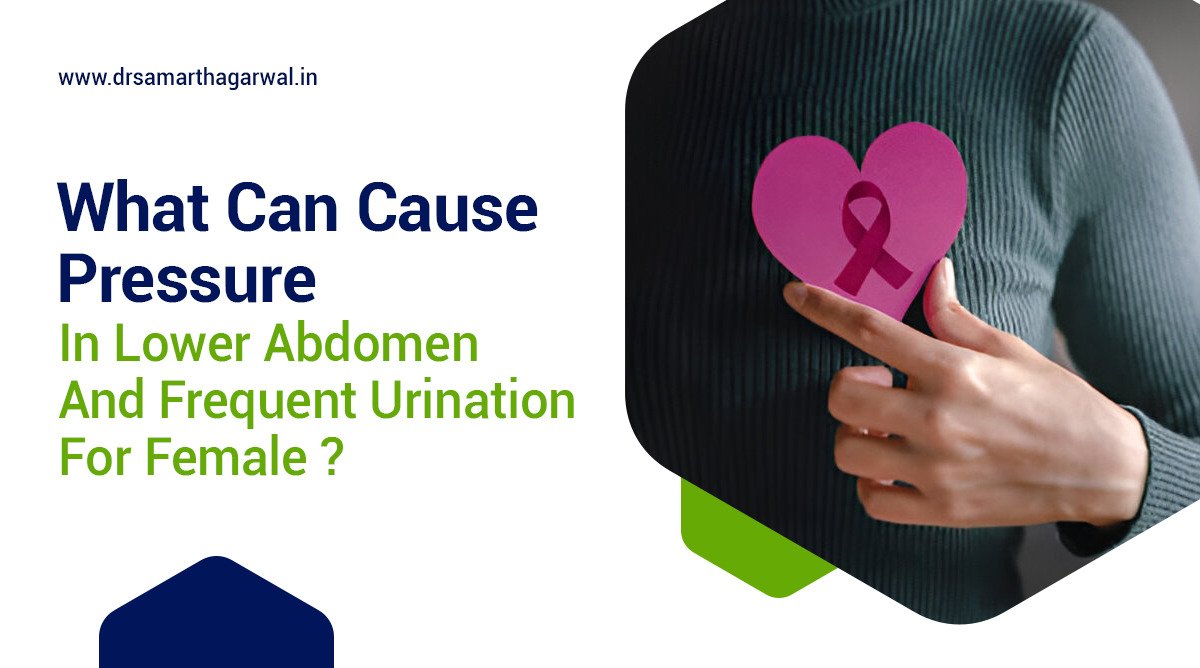Experiencing pressure in the lower abdomen accompanied by frequent urination can be a source of concern for many women. Gaining a comprehensive understanding of the potential causes can offer valuable insights into one’s health. Various factors may contribute to these symptoms, ranging from urinary tract infections to conditions such as endometriosis and ovarian cysts. This article will examine these common causes, outline when it is advisable to seek medical consultation, and discuss possible treatment options, with insights from Dr. Samarth Agarwal, a urologist committed to women’s health.
What Are The Common Causes of Pressure in Lower Abdomen and Frequent Urination for Female?
Pressure in the lower abdomen and frequent urination in females can arise from various health issues, ranging from urinary tract infections (UTIs) to chronic conditions such as interstitial cystitis and hormonal changes associated with menstrual cycles. Understanding these causes is crucial to managing symptoms effectively and maintaining good pelvic health.
Factors like emotional stress and pelvic health also contribute significantly to this discomfort, thereby affecting the quality of life for many women. Additionally, issues such as bladder dysfunction and bladder control problems can exacerbate these symptoms.
Being aware of these conditions can guide individuals towards seeking appropriate medical attention to alleviate discomfort and ensure a healthier lifestyle.
Urinary Tract Infection (UTI)
A urinary tract infection (UTI) is a common cause of pressure in the lower abdomen and frequent urination, often presenting symptoms like increased urinary urgency and discomfort.
This discomfort is primarily due to the inflammation of the bladder wall, which can lead to an intense sensation of needing to void, even when the bladder is not full. This inflammation can also cause bladder pain and bladder irritation.
Individuals may experience burning sensations during urination, cloudy urine, or even a particular odor. As the infection progresses, symptoms may worsen, indicating a crucial need for prompt intervention.
- Causes: Common culprits include bacteria such as Escherichia coli, which may enter the urinary tract through improper hygiene practices or sexual activity.
- Symptoms: Alongside urgency, individuals may notice fever, chills, or back pain, suggesting a potential kidney involvement.
Many treatment options are available, ranging from prescribed antibiotics to increased fluid intake to flush the system. Additionally, practicing bladder retraining and maintaining a bladder diary can help manage symptoms effectively.
Importantly, consulting a healthcare provider is essential not only to confirm the diagnosis but to tailor an effective treatment plan, ensuring recovery is swift and complete.
Bladder Infection
Bladder infections can lead to significant bladder pain and increased urinary frequency, often requiring prompt medical intervention to avoid further complications.
When these infections occur, individuals frequently experience a burning sensation during urination, urgency to urinate, and sometimes even blood in the urine. These symptoms may also be accompanied by urinary frequency and night urination.
It’s crucial to recognize these urinary symptoms as signs that should not be ignored, as they may indicate a more severe underlying issue like bladder stones or chronic bladder pain.
Treatment options typically involve antibiotics, which can effectively eliminate the bacterial infection. Incorporating adequate hydration and possibly using pain relief medications can also alleviate discomfort.
- Patients are advised to consult healthcare providers to establish tailored treatment plans.
- Understanding personal risk factors and preventive measures is equally important.
Seeking timely medical attention give the power tos individuals to manage this condition effectively and enhances overall urinary health.
Overactive Bladder
An overactive bladder is characterized by an uncontrollable urge to urinate frequently, which can drastically affect a woman’s quality of life and overall bladder control, leading to interruptions in daily activities, social engagements, and even sleep patterns. This condition may result in bladder spasms and bladder signaling issues.
Many individuals experience discomfort and embarrassment due to unexpected leaks or constant restroom trips, contributing to not only physical distress but emotional struggles as well.
This persistent condition often results in anxiety and frustration, making it difficult for individuals to engage fully in their lives. The psychological impact can amplify feelings of isolation and depression, creating a negative cycle that is hard to escape.
To manage symptoms effectively, individuals are encouraged to explore a variety of treatment options. These may include:
- Behavioral therapies: Strategies such as bladder training and pelvic floor muscle exercises can enhance control.
- Medications: Certain prescriptions may help relax the bladder muscles, providing relief from urgency.
- Lifestyle changes: Adjustments in diet, such as reducing caffeine and alcohol intake, along with maintaining a healthy weight, can significantly alleviate symptoms.
Considering these approaches can help restore balance and improve overall emotional well-being, enabling individuals to regain a sense of normalcy in their lives.
Interstitial Cystitis
Interstitial cystitis, often referred to as painful bladder syndrome, is a chronic condition that can manifest as persistent pelvic pain and pressure in the bladder area. This condition can involve chronic pain and significantly affect quality of life.
This complex ailment can significantly disrupt daily life, leading not only to physical discomfort but also emotional distress. Individuals may experience a range of symptoms that vary in intensity, including:
- Frequent urination and urinary urgency
- Urgency to urinate
- Pelvic pressure or discomfort
- Pain during sexual intercourse
The exact causes of interstitial cystitis remain uncertain; however, several factors are believed to contribute to its onset. These may include:
- Protective lining of the bladder
- Autoimmune reaction
- Chronic infections
- Pelvic floor dysfunction and weakened bladder capacity
Given the significant impact on emotional well-being, it is crucial to recognize the importance of bladder health and to implement effective management strategies, such as pelvic floor exercises and pain management techniques.
Treatment options like bladder instillations, dietary modifications, physical therapy, and medications can prove beneficial in alleviating symptoms and improving quality of life.
Pelvic Inflammatory Disease (PID)
Pelvic inflammatory disease (PID) is an infection of the female reproductive organs that can result in significant pelvic pain and pressure in the lower abdomen, often influenced by sexual activity. This condition can cause severe health issues if not promptly treated.
This condition is primarily a result of untreated sexually transmitted infections (STIs) such as chlamydia and gonorrhea, as these bacteria can ascend from the vagina into the uterus, fallopian tubes, and surrounding tissues, leading to inflammation.
As PID progresses, symptoms may intensify and can include:
- Chronic pelvic pain: persistent pain that can drastically affect daily activities and sexual intimacy.
- Abnormal vaginal discharge: which may have an unusual odor.
- Fever: often indicating a more severe infection.
- Painful intercourse: discomfort during or after sexual activity.
The impact on pelvic health can be considerable, potentially resulting in long-term complications such as infertility, ectopic pregnancy, or continuous pelvic pain. Additionally, untreated PID can lead to more severe infections and chronic pain.
Due to these risks, it is essential for individuals experiencing symptoms to seek medical attention promptly. Treatment often involves antibiotics to eradicate the infection, and in severe cases, surgery may be necessary. Regular follow-ups with a healthcare provider are also crucial to monitor and manage the condition effectively.
Early intervention is crucial for managing this condition effectively and safeguarding reproductive health.
Endometriosis
Endometriosis is a chronic condition where tissue similar to the lining of the uterus grows outside it, often leading to significant pelvic pain and discomfort, especially during menstruation, affecting both physical well-being and emotional health. This condition frequently involves chronic pain and may require specialized treatment options.
Women experiencing this condition may note various symptoms such as heavy periods, pain during intercourse, and even complications with fertility. The hormonal changes associated with endometriosis can exacerbate these symptoms, resulting in inflammation and scarring in the pelvic area. Recognizing these signs is crucial because prompt diagnosis can help prevent further complications.
Medical intervention is essential for managing endometriosis effectively, offering various treatment options including:
- Hormonal therapies that regulate the menstrual cycle
- Pain management strategies
- Surgical options to remove endometrial tissue
- Fertility treatments for those affected by infertility
With proper care and treatment, individuals can significantly improve their quality of life and tackle the challenges posed by this condition.
Ovarian Cysts
Ovarian cysts are fluid-filled sacs on the ovaries that can lead to pelvic pain and pressure, often exacerbated by hormonal fluctuations during the menstrual cycle.
These cysts can develop at various stages of a woman’s life, particularly during reproductive years. They may form due to normal physiological processes, such as ovulation, or can arise from other underlying issues like hormone fluctuations and autoimmune reactions.
While many women experience minimal symptoms, some may notice discomfort, bloating, or irregular menstrual cycles as their signs.
As these cysts grow, they can exert increased pressure on surrounding organs, including the bladder, leading to frequent urination or difficulty in maintaining bladder control. Some women may also experience symptom-free periods wherein the cysts shrink temporarily.
- Common symptoms include:
- Pelvic pain
- Nausea
- Difficulty emptying the bladder
In most cases, ovarian cysts resolve independently, but persistent or severe symptoms vary and warrant medical evaluation.
Effective treatment strategies range from lifestyle modifications to hormonal therapies, and, in certain instances, surgical intervention may be necessary. It’s crucial to consult a healthcare provider if unusual symptoms arise or exacerbate over time, as they can lead to significant health consequences.
Uterine Fibroids
Uterine fibroids are noncancerous growths in the uterus that can cause pelvic pain, increased pressure in the lower abdomen, and heavy menstrual bleeding. These are important considerations in women’s health.
These growths, which vary greatly in size and can be found on the uterine wall or inside the uterus, can contribute to a wide range of symptoms that may affect an individual’s quality of life significantly. Women experiencing uterine fibroids might notice:
- Frequent urination due to pressure on the bladder
- A sense of fullness in the lower abdomen
- Pain during intercourse
In some cases, fibroids might lead to complications such as infertility or pregnancy-related issues. It’s crucial for those facing these symptoms to seek guidance from a healthcare provider, who can offer insights on management options such as medication, lifestyle changes, or surgical procedures. Consulting a health care provider ensures appropriate treatment.
Understanding the available treatment options can give the power to individuals to make informed decisions about their health.
Pregnancy
During pregnancy, women often experience increased pelvic pressure and urinary frequency due to hormonal changes and the growing uterus pressing on the bladder, sometimes exacerbated by diuretic beverages.
This pressure can lead to the frequent urge to urinate, particularly in the later stages as the fetus grows larger. These physiological changes can cause discomfort and sometimes feelings of anxiety about being too far from a restroom.
To alleviate these symptoms, it’s beneficial to stay hydrated but also to manage fluid intake, particularly before bedtime. Kegel exercises can help strengthen pelvic floor muscles, offering some relief from pressure.
If urinary issues are accompanied by pain, burning sensations, or changes in the appearance of urine, it is advisable to consult a healthcare provider to rule out potential urinary tract infections, Interstitial cystitis, or other complications.
Menopause
Menopause brings about hormonal fluctuations that can significantly impact bladder function, leading to symptoms such as frequent urination and discomfort. These changes are a crucial part of the urinary network.
During this transitional phase, many women may find that these alterations not only disrupt daily activities but also detract from overall quality of life. The decline in estrogen levels can exacerbate urinary tract issues, making it crucial to understand the relationship between hormonal changes and urinary health. Proper education on this matter can give the power to individuals to seek effective solutions, ensuring informed decisions regarding health consequences.
- Potential Treatments: Various treatments exist, including hormone replacement therapy (HRT), which can alleviate symptoms for some.
- Lifestyle Adjustments: Adopting a balanced diet, maintaining hydration, and incorporating pelvic floor exercises can also significantly improve symptoms.
- Consultation: Regular consultations with healthcare providers can facilitate personalized treatment plans tailored to specific needs.
Being proactive and informed can lead to better management of urinary health challenges associated with menopause.
When Should You See a Doctor?
It is crucial to seek medical attention when experiencing persistent urinary symptoms or severe pelvic pain, as these may indicate underlying health issues such as prostate inflammation or other conditions that require professional evaluation.
Ignoring such discomfort can lead to complications that may significantly impact quality of life. Common warning signs include:
- Frequent urination
- Pain or burning sensations during urination
- Blood in urine
- Unexplained pelvic pressure
- Severe lower abdominal pain
Recognizing these symptoms early can facilitate a more effective treatment plan, making it vital for individuals to prioritize their health. Addressing these issues promptly not only allows for early diagnosis and intervention but also helps in managing potential chronic conditions that could escalate without proper care.
How is Pressure in Lower Abdomen and Frequent Urination Diagnosed?
Diagnosing the causes of pressure in the lower abdomen and frequent urination typically involves consulting a healthcare provider, who may recommend tests to evaluate bladder function and pelvic health.
During this diagnostic process, the healthcare provider may suggest various assessments to gain a comprehensive understanding of the underlying issues. Initially, keeping a bladder diary can help track urinary habits and symptoms over several days. This documentation aids in identifying patterns and potential triggers that may contribute to the discomfort.
- A thorough physical examination might be conducted to locate any anatomical abnormalities or tenderness in the pelvic region.
For further investigation, imaging studies such as:
- ultrasounds
- CT scans
may be utilized to visualize the bladder and surrounding organs. Depending on the findings, specialized tests to assess bladder function, including urodynamic studies, can provide critical insights into how effectively the bladder is performing its role.
Through these methods, a tailored treatment plan can be developed, addressing the unique needs of the individual.
What are the Treatment Options for Pressure in Lower Abdomen and Frequent Urination?
Discover effective treatment options to alleviate pressure in the lower abdomen and frequent urination. Explore physical therapy, medication, behavioral changes, antibiotics, electrical nerve stimulation, surgery, chemotherapy, and biofeedback therapy for potential solutions.
Treatment Options for Pressure in Lower Abdomen and Frequent Urination
- Physical Therapy: Strengthening the pelvic floor muscles through exercises like Kegels can improve bladder control.
- Pentosan Polysulfate Sodium: This medication may be used to block irritants in urine, reducing bladder pressure.
- Behavioral Changes: Modifying diet and fluid intake, especially reducing caffeine and alcohol, can help alleviate symptoms.
- Antibiotics: Infections are typically treated with antibiotics, if they are the cause of the symptoms.
- Electrical Nerve Stimulation (TENS): This treatment may help relieve symptoms by increasing blood flow to the bladder and strengthening pelvic muscles.
- Surgery: For severe cases, surgery may be considered to correct any physical issues causing the pressure and frequent urination.
- Chemotherapy, Radiation, and Other Treatments: These are common treatments for cancer, which can cause pressure in the lower abdomen and frequent urination. Other options include targeted therapy, immunotherapy, and hormonal therapy.
- Biofeedback Therapy: Combined with Kegel exercises, this treatment can help a person become more aware of their body’s functions to better manage symptoms.

Contact Dr. Samarth Agarwal if you have any questions or concerns about your Urinary health!




